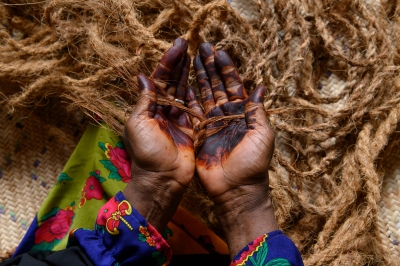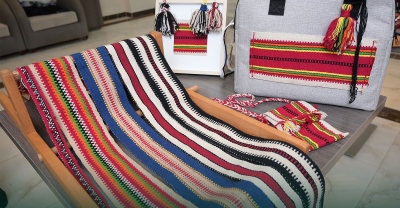
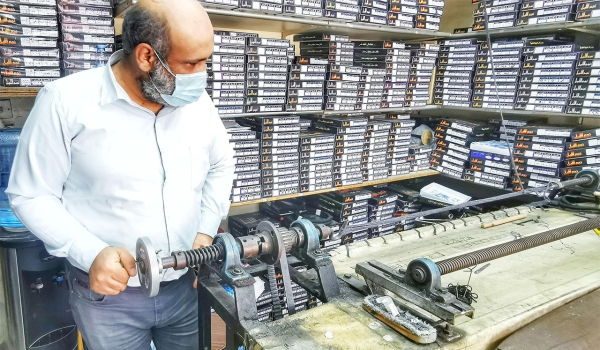
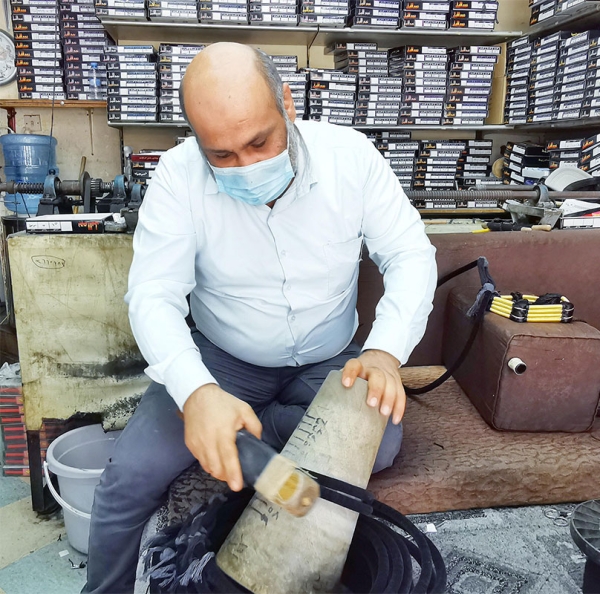
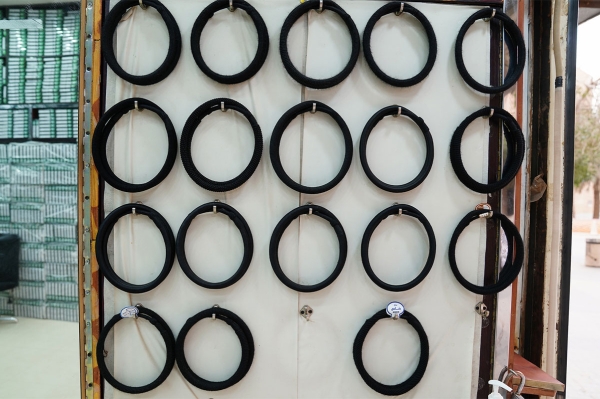
Al-Egal Craftsmanship in the Kingdom of Saudi Arabia is one of the most prominent traditional handicrafts in the Kingdom. Its significance stems from ancient customs in the Arabian Peninsula and al-Egal's strong association with prestige and status.
The origin of al-Egal name
Al-Egal is worn over the Ghutra to keep it securely in place on the head. Its name may have originated from the traditional use of al-Egal by Arabs to tie and restrain camels, preventing them from wandering. Once no longer needed for this purpose, it was placed on the head, possibly as a practical way to keep it safe. Another theory suggests that the name comes from its similarity to the round rope used for restraining camels.
Tool used in al-Egal making
The tool used to craft the al-Egal is made up of several components. First, there's the Dazqa, a rectangular wooden base about two m long and one m high. At each end of this base, there are five holes where a stick-like tool, known to craftsmen as the Saba' al-Dazqa, is inserted. Each stick has a single Saba' at its end, and the two ends of al-Egal are secured to the top of these Saba' with a twisted thread called Mouna. To maintain space during the winding process of the black silk and fiber threads, a zigzag wooden piece is placed between them. The threads are then twisted around a small wooden rod called the Malaf, while another rod is used specifically for the fiber. Once the winding process is complete, the craftsman unties al-Egal from the two Saba' of the tool.
Al-Egal is made from both natural and synthetic threads. The natural thread is typically goat hair, velvet, or silk. The most commonly used is a natural wool thread, known for its durability, shine, and elegant appearance, making it the preferred choice. Synthetic Egal, on the other hand, is made from nylon threads. The type of thread used largely determines the price of al-Egal. Handmade Egals are more expensive than machine-made ones, especially when the craftsmanship involves intricate twisting, which adds to the price. The cost also fluctuates depending on how it is made and the timing of its sale. During festive occasions and holidays, prices tend to rise due to increased demand, as people seek new or custom-made Egals with specific features requested by the buyer.
Stages of al-Egal making
Al-Egal is now tailored using a variety of tools, including machines with two supports for making the lining and winding the outer layer, a wooden mallet used to adjust al-Egal’s shape and its roundness, a double length twister or spindle for twisting the threads, a mold for measuring and shaping al-Egal, and a metal brush to clean the surface. Additional tools include needles, scissors, and a comb.
The production process begins with putting a white cotton filling on the machine or the wooden base. It is then covered with black cotton, over which a black thread, either natural or synthetic, is wound using the spinning technique. The next stage is Kasrat al-Egal, where the two ends are joined, tied, and knotted. This is followed by the Tadris stage, where the two ends are stitched, knotted, and covered. The final stage is the weighing of al-Egal, where its weight and measurements are adjusted using the mold and wooden mallet. The length and size of al-Egal are determined according to the customer's preferences, with sizes ranging from thirty for children to sixty-five for adults.
Types of al-Egal
Al-Egal comes in various types. The most commonly used today is the black Egal, made from fine wool threads wrapped around a circular core that has twice the circumference of the desired size. This is because al-Egal is folded into two circles, one atop the other, to create multiple sizes to fit different head shapes. The thickness of al-Egal can vary. Historically, much thicker versions were used compared to those in use today. Some older versions even featured two long cords of decorative gimps hanging from the back for decoration. The black Egal itself has several types, including cotton, velvet, silk, wool, and plastic variations. Its size is determined by head measurements, with the most common sizes ranging between forty-five and fifty-six, and thickness between 4.5 and 5.6 cm. The circumference of the round-shaped Egal measures about 110 cm.
Another type is the white Egal, which closely resembles the modern black Egal but predates it. However, the white Egal is no longer in common use. There is also the "Muqassab" Egal, also known as the (Shatfah), a pentagon-shaped design made of two layers with ten sides in total. This type has a soft, flexible part at the back, allowing it to fold into two layers. A small, black, woolen-knotted sphere sits between each pair of adjacent sides. Each side of al-Egal is made from two thin cylinders placed one over the other, wrapped entirely with gold or silver threads, which hold them together. The "Muqassab" Egal is typically worn by royalty, nobles, and tribal leaders in the Kingdom and other Arab countries, such as Kuwait, Iraq, and Bahrain, giving the wearer an air of prestige. The "Muqassab" resembles the Shatfah Egal, but its knots are smaller, and it features more elaborate braids of gold or silver thread.
Faisal Egal
One of the most famous figures to wear the "Muqassab" Egal was King Abdulaziz, along with his sons King Saud and King Faisal. The "Shaftah Muqassab" Egal adorned with golden braids became famously known as the "Faisal Egal." There is also a version of the "Muqassab" Egal where the core thread of each side is visible in a dark brown shade, peeking through the gold thread wrapping. This type is typically worn by people from Iraq and Kuwait. Another variant of the "Shatfah" Egal does not use gold threads "Zari" for decoration, instead its sides are covered solely with white wool threads. When worn, the two front corners of al-Egal sit on either side of the forehead, while the two adjacent corners rest behind the head. The soft part of al-Egal lies at the center of the back of the head.
Al-Egal makers
Several families in various Saudi cities have become renowned for their craftsmanship in al-Egal-making. In al-Madinah al-Munawwarah, for instance, the well-known al-Egal makers included Sheikh Hussein Roshon, Sheikh Mohsen Youssef Awad, and his brother Hussein, both sons of Sheikh Youssef Awad, as well as Sheikh Amin Bari and Sheikh Omar Abu Seif. In Makkah al-Mukarramah, the Abu Rish family became famous for their al-Egal-making, with Sheikh Saleh Abdulrahman Abu Rish being recognized as the master of al-Egal craftsmen in Makkah al-Mukarramah.
Related quizzes
Related articles
